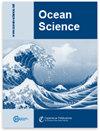基于模拟的地中海海洋垃圾浓度预报系统
IF 3.3
3区 地球科学
Q2 METEOROLOGY & ATMOSPHERIC SCIENCES
引用次数: 0
摘要
摘要在这项工作中,我们探索了地中海海洋垃圾浓度统计预测系统的性能。特别是,我们基于类似物方法评估系统的潜在技能。该系统使用高分辨率现实模型模拟的海洋垃圾浓度历史数据库,并经过训练以识别过去与预测相似的气象情况。然后,利用过去模拟日对应的海洋凋落物浓度构建海洋凋落物浓度预报。由于观测资料的缺乏,预测系统已根据综合现实(即海洋垃圾模拟系统的输出)进行了验证。试验了不同的方法来改进系统,结果表明,基于气象情况的历史,使用相似函数的积分定义提高了系统的性能。我们还发现,系统的精度取决于应用领域,对于更大的区域更好。此外,该方法在捕获空间模式方面表现良好,但在捕获时间变异性,特别是极端值方面表现较差。尽管使用综合现实来验证系统存在固有的局限性,但结果是有希望的,并且该方法有可能成为适合的经济有效的海洋垃圾浓度预测方法。本文章由计算机程序翻译,如有差异,请以英文原文为准。
An analogues-based forecasting system for Mediterranean marine-litter concentration
Abstract. In this work, we explore the performance of a statistical forecasting system
for marine-litter concentration in the Mediterranean Sea. In particular, we
assess the potential skills of a system based on the analogues method. The
system uses a historical database of marine-litter concentration simulated
by a high-resolution realistic model and is trained to identify
meteorological situations in the past that are similar to the forecasted
ones. Then, the corresponding marine-litter concentrations of the past
analogue days are used to construct the marine-litter concentration
forecast. Due to the scarcity of observations, the forecasting system has
been validated against a synthetic reality (i.e., the outputs from a marine-litter-modeling system). Different approaches have been tested to refine
the system, and the results show that using integral definitions for the
similarity function, based on the history of the meteorological situation,
improves the system performance. We also find that the system accuracy
depends on the domain of application being better for larger regions. Also,
the method performs well in capturing the spatial patterns but performs worse
in capturing the temporal variability, especially the extreme values. Despite
the inherent limitations of using a synthetic reality to validate the
system, the results are promising, and the approach has potential to become a
suitable cost-effective forecasting method for marine-litter concentration.
求助全文
通过发布文献求助,成功后即可免费获取论文全文。
去求助
来源期刊

Ocean Science
地学-海洋学
CiteScore
5.90
自引率
6.20%
发文量
78
审稿时长
6-12 weeks
期刊介绍:
Ocean Science (OS) is a not-for-profit international open-access scientific journal dedicated to the publication and discussion of research articles, short communications, and review papers on all aspects of ocean science: experimental, theoretical, and laboratory. The primary objective is to publish a very high-quality scientific journal with free Internet-based access for researchers and other interested people throughout the world.
Electronic submission of articles is used to keep publication costs to a minimum. The costs will be covered by a moderate per-page charge paid by the authors. The peer-review process also makes use of the Internet. It includes an 8-week online discussion period with the original submitted manuscript and all comments. If accepted, the final revised paper will be published online.
Ocean Science covers the following fields: ocean physics (i.e. ocean structure, circulation, tides, and internal waves); ocean chemistry; biological oceanography; air–sea interactions; ocean models – physical, chemical, biological, and biochemical; coastal and shelf edge processes; paleooceanography.
 求助内容:
求助内容: 应助结果提醒方式:
应助结果提醒方式:


